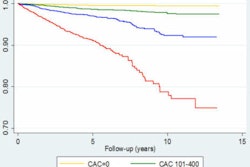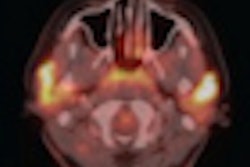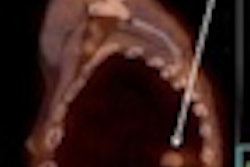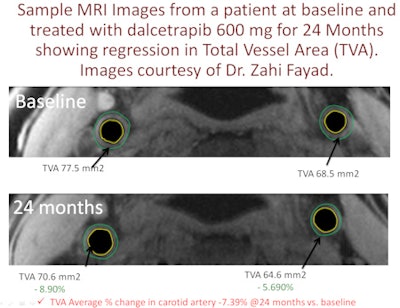
In a study being touted as the first to use noninvasive imaging to test the efficacy of an atherosclerosis drug, researchers found that dalcetrapib reduced arterial inflammation and disease progression at PET/CT and MRI, respectively, according to results published September 12 in the Lancet.
Patients in the phase IIB multicenter dal-PLAQUE study who were randomized to receive dalcetrapib had a 31% increase in high-density lipoprotein (HDL) cholesterol at MRI, the group reported. In addition, PET/CT showed that inflammation levels in the carotid artery of dalcetrapib patients were reduced, while remaining unchanged in the placebo group (Lancet, September 12, 2011).
Dalcetrapib, a drug in development by Hoffman-La Roche, is a cholesterol ester transfer protein (CETP) inhibitor, a class of drug that raises HDL or "good" cholesterol. The research was funded by the manufacturer.
"This milestone study shows that MRI and PET/CT are highly useful in assessing the safety and efficacy of dalcetrapib, and that this novel therapy may address a significantly unmet need in cardiovascular disease," said lead investigator Dr. Zahi Fayad, PhD, professor of radiology and medicine at Mount Sinai, in a statement accompanying the study's release. "We are excited about the results obtained in this trial, which could have a great impact on the treatment of patients with cardiovascular disease."
Via the two imaging modalities, the authors aimed to determine whether dalcetrapib causes an increase in atherosclerotic plaque progression or vascular inflammation, compared with placebo.
"By directly measuring the effect on the vessel wall of cumulative cardiovascular risk factors combined, these noninvasive imaging techniques can serve as valuable biomarkers," Fayad explained.
In total, 130 patients were assigned to either dalcetrapib (64 patients) or placebo (66 patients). The patients were all clinically stable but had 10-year Framingham risk of coronary heart disease events greater than 20%, triglyceride concentrations of 400 mg/dL or lower, and a carotid or aortic arterial wall (target) to background (blood) ratio (TBR) of 1.6 or higher based on PET/CT using FDG, the authors wrote.
Blood samples were acquired to measure total cholesterol, triglycerides, HDL-C, LDL-C, and lipoprotein subfractions at baseline and at one month, three months, and every three months thereafter until 24 months. Screening for apolipoproteins B and A1 was performed on a similar schedule.
Imaging included MRI of the carotid arteries and abdominal aorta using previously validated techniques. FDG-PET was used to scan the carotid arteries and thoracic aorta. Finally, mean and maximum standardized uptake value (SUV) was measured along the carotids and ascending aorta axially at about 5-mm intervals, the authors wrote.
The imaging studies were evaluated at the core laboratory by four experienced readers blinded to the results: two readers for MRI and two for PET/CT.
For the MRI and PET/CT end points, all of the results showed that confidence intervals (CI) were either below the no-harm boundary or the adverse change was numerically lower in the dalcetrapib group than in the placebo group. In addition, no proatherogenic effect of dalcetrapib therapy compared with placebo was seen at MRI after 24 months, according to plaque measurements.
The total vessel area (average carotid) was decreased with dalcetrapib compared with placebo after 24 months, the group wrote. The absolute change from baseline relative to placebo was -4.01 mm2 (90% CI: -7.23 to -0.80; nominal p = 0.04).
PET/CT-derived results showed no evidence of increased vascular inflammation with dalcetrapib compared to placebo after six months.
The PET/CT measure of index vessel most-diseased-segment TBR was similar in both patient groups. However, carotid artery analysis showed a 7% reduction in most-diseased-segment TBR in the dalcetrapib group, compared with the placebo group (-7.3 [90% CI: -13.5 to -0.8]; nominal p = 0.07).
The drug did not increase blood pressure readings, and the frequency of adverse events was similar between the placebo and drug groups, the authors reported.
There was a numerical reduction in vessel wall area (p = 0.12) when dalcetrapib treatment was compared with placebo after 24 months. "Total vessel area increased less with dalcetrapib than with placebo (p < 0.05)," according to the authors.
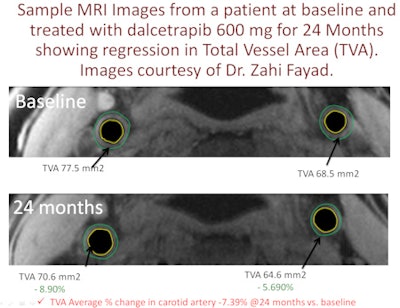 |
Laboratory changes, including liver transaminases and creatine phosphokinase assessments, did not differ between the placebo and dalcetrapib patients; creatine phosphokinase was raised in five (8%) patients in the placebo group and vital signs did not differ between groups.
Use of the drug "did not increase plaque progression over 24 months or inflammation in the vessel wall over six months compared with placebo," Fayad and colleagues concluded, noting that the imaging results accompanied an early increase in HDL-C concentration of 31% "and other potentially beneficial changes in the lipid profile, which were maintained during 24 months."
In the dalcetrapib group, concentrations of apolipoprotein A1 increased by 10% at 24 months from mean baseline levels. Lp-PLA2 mass, a marker of inflammation, decreased from baseline after 24 months with placebo (-0.36%) and increased with dalcetrapib. Meanwhile, cholesterol ester transfer protein (CETP) activity decreased (-55.5%) and CETP mass increased (77.2%) with dalcetrapib versus placebo at 24 months.
Carotid vessel analysis
"Carotid vessel analysis of FDG-PET/CT data showed a reduction in vascular inflammation over six months in the dalcetrapib group relative to the placebo group, which seemed to be correlated with an increase in HDL-C concentrations," Fayad and colleagues wrote.
Reductions in inflammation in the carotid arteries at six months were found to be associated with a reduction in the rate of increase in total wall vessel area by MRI at six months.
"Hence, taken together, the data suggest that dalcetrapib might reduce adverse structural changes within the blood vessel via a mechanism relating to reduced vascular inflammation and increased HDL-C concentrations, Fayad and colleagues wrote.
Imaging enables smaller future studies
The first drug in the dalcetrapib group to be studied, torcetrapib, was effective in increasing HDL cholesterol but caused a significant increase in mortality due to vascular inflammation.
Therefore, considering the debate about the proatherogenicity or antiatherogenicity of CETP activity, "the multimodality imaging techniques used in the dal-PLAQUE study were deemed a useful biomarker approach to increase confidence that CETP modulation with dalcetrapib does not cause short-term harm while results from larger outcomes trials were pending," they wrote.
The use of imaging could greatly diminish the necessary cohort sizes compared to intravascular ultrasound or carotid artery intima-media thickness studies, Fayad and colleagues noted.
In addition, they wrote, FDG-PET, which measures vessel-wall inflammation noninvasively, could differentiate between symptomatic and asymptomatic carotid artery plaques with excellent reproducibility while predicting both older and more recent cardiovascular disease history.
These properties have made the modality useful for evaluating the efficacy of drug treatment or lifestyle changes, the authors wrote.
However, the predictive value for future cardiovascular events based on vessel wall morphometrics by MRI has not yet been examined in the long term, the group wrote. "Vessel-wall thickness by MRI is highly correlated with ultrasound [carotid intima media thickness], however, so it is to be expected that the predictive value of MRI would be similar," the authors wrote.
Increases in total vessel area over time versus the placebo group seemed to be greater than increases in wall area, "which might be evidence of excessive, maladaptive vascular enlargement that could render the arteries more vulnerable," they wrote. "This possibility is supported by the finding that greater increase in total vessel area on MRI seemed to be related with more vascular inflammation on PET/CT, as measured by most-diseased-segment TBR.
Fortunately, dalcetrapib seemed reduced the increase in total vessel area over time accompanied by reduced increase in wall area over time.
Among the study's limitations, it is noteworthy that the favorable results on PET/CT were recorded in the carotid arteries but not the index vessel, the authors wrote. In addition, changes in HDL-C or baseline HDL-C were not correlated with MRI indices of plaque burden, though such changes seemed to be inversely correlated with TBR at PET/CT at six months.
Two large, ongoing clinical trials of the drug -- dal-PLAQUE 2 and dal-OUTCOMES -- "will provide further insights into the therapeutic effects of dalcetrapib," the group wrote. The long-term safety and clinical efficacy of the drug awaits completion of the dal-OUTCOMES study.





